
Peperomia plants make excellent indoor plants.
©heru pujianto/Shutterstock.com
There are 1000 varieties of peperomia plants. Peperomia plants are small, they prefer indirect sunlight, and they make amazing houseplants. Peperomia plants are native to the tropical and subtropical regions of the world.
These plants are versatile enough to be planted in small containers and placed on shelves or desktops. There are trailing varieties perfect for hanging baskets. The plants are easy to care for, and add beauty to your home or office space.
In their native environments the peperomia grow outdoors. They are found growing on the trunks of trees and as ground cover. Peperomia are not cold tolerant.
1. Albovittata Peperomia or Piccolo Banda
The Albovitta peperomia is native to Ecuador. It has deep green leaves highlighted by orange-brown veins. The plant requires moderate moisture and temperatures between 65-85°F. Humidity levels of no more than 60%.
Keep the plant in an area with indirect light. Use a potting mixture that provides a lot of air flow to the roots. Albovittas are drought tolerant, semi-succulents. They reach heights between 8 and 12 inches.
2. American Rubber Plant
Peperomia American Rubber plants grow to heights of 8 to 10 inches. Although the name is like the Rubber Tree the American Rubber plant piperomia has blunt leaves and is from the Peperomia genus. The rubber tree plant is from the Ficus elastica. The similarity in the plants is the blunt leaves that are deep green.
This plant pairs perfectly with tall cylindrical containers. It is an indoor plant that requires little attention, however the soil it is planted in must drain well.
3. Argyreia Peperomia (Watermelon Peperomia)
The Argyreia Peperomia plants grow to heights of 6 and 8 inches. The leaves are medium to dark green with lighter green stripes like you see on a watermelon. They are native to northern south America, Bolivia and Brazil. Wait to water these peperomia types until the top inch of soil in their container is dry.
These plants do great in small containers or hanging baskets. They require very little water so there is no concern of dripping on carpets or desks.
4. Aussie Gold Peperomia
Golden leaves that are heart shaped are dominant on the Aussie Gold peperomia. The plants grow to a maximum height of 10 inches. These peperomia types are native to Australia and need low light, and medium amounts of water.
The Aussie gold adds color and interest to your indoor plant garden. They do well in containers and in hanging baskets. Indirect sunlight is best so they are good in rooms that have few windows.
5. Beetle Peperomia
This is a medium size peperomia that reaches a mature height of 12 inches. It is a trailing plant with a dominat feature of leaves that are striated emerald green. They make excellent plants for hanging baskets. Low lighting or filtered lighting is required with minimum watering.
The vines are sturdy and the plant does not shed if it is properly cared for. Soil type is a concern and needs to be well draining and aerated.
6. Belly Button Peperomia
The Belly Button peperomia is a large plant for this plant species. Mature plants grow to be 3-feet. These plants are drought tolerant. They need very little water, low light, warm temperatures and feeding only in the spring. Belly Button peperomias are great for indoor gardens, and houseplants.
In zones 10 through 12 the Belly Button peperomia does well in outdoor gardens that have sandy soil. Overfertilization can be problematic when the plants are grown outdoors.
7. Bibi Peperomia
A Bibi peperomia grows to a height of 7 to 10 inches. These peperomia types are native to Africa, Southern Asia and Central America. They are unique with medium to dark green foiliage that is elongated and thin. Use regular potting soil when potting the plants. Keep the soil moist and mist the plant occasionally.
These are one of the easiest peperomia to care for. They look great in hanging pots because of their elongated and dropping foiliage.
8. Brazilian Peperomia
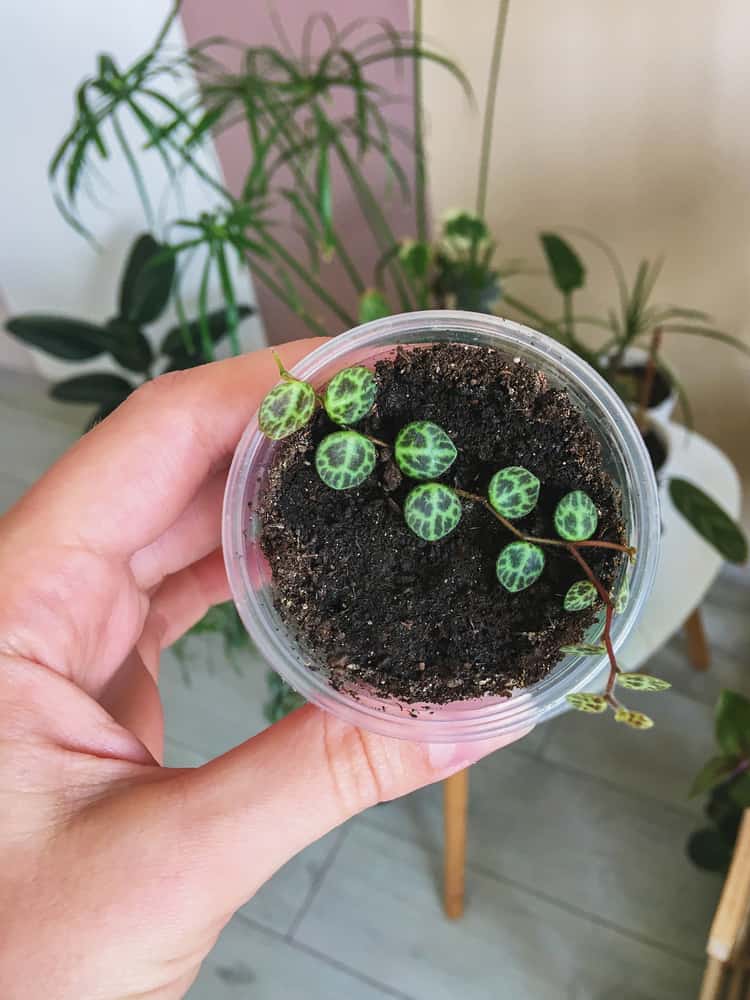
This Turtle Pepercomia plant is a Brazilian native.
©Cozy Home/Shutterstock.com
The Braziliam peperomia is up to 16 inches tall when mature. It is native to the Brazilian rainforest. They require little care and propagating them is easily done. This peperonia type is free flowering throughout the year. They make perfect plants for offices and rooms with low light.
The small plants require little water. To keep from overwatering them test the soil and do not add water until the top inch of soil is dry.
9. Citrus Twist Peperomia
A citrus peperomia mature4s at a height of 8 to 12 inches. This plant needs indirect sunlight. It can thrive in direct sunlight for short periods of time. If the conatiner is in indirect light you will water the citrus peperomia once every nine days. The soil should drain well so the roots are not kept in a moistened state. Too much water causes root rot.
10. Columbian Peperomia
The columbian peperomia grows to a mature height of 8 inches. This variety of peperomia is a low maintenance plant. Every nine days give the plant 0.8 cups of water. Keep the plant in indirect sunlight. Provide a warm tempature and maintain a humidity level of 70% in the room the plant lives in.
11. Columella Peperomia
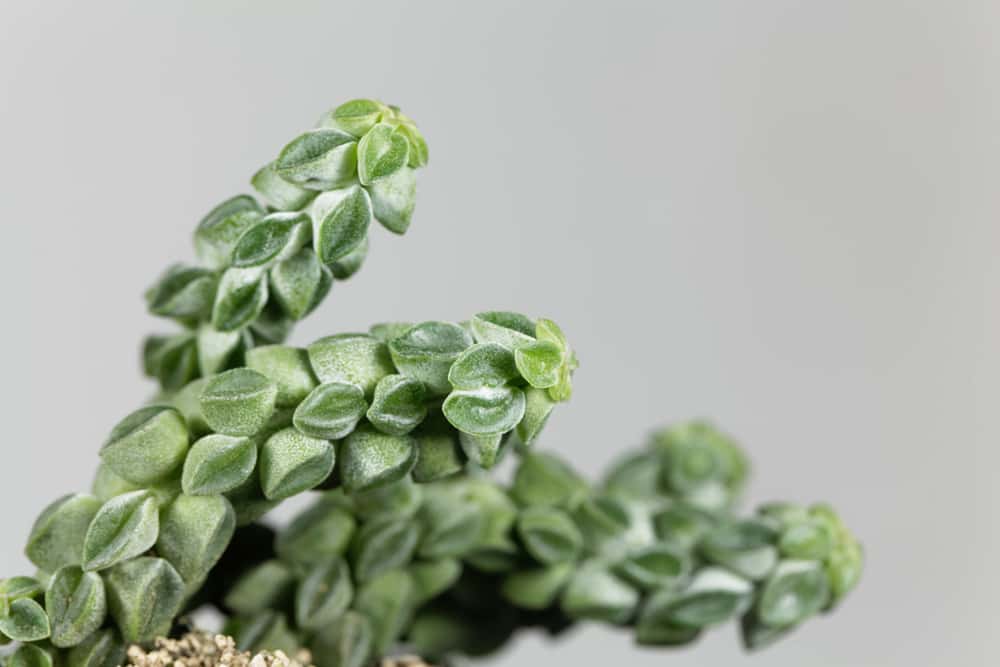
The Columella grows in slender columns with medium green foiliage.
©ChWeiss/Shutterstock.com
A native of Peru the Columella peperomia is between 6 and 10 inches when mature. It has a distinctive appearance with tall slender columns. The leaves of the plant are horseshoe shaped, small and bright green. They are excellent for indoor plants.
12. Cubensis Peperomia
The Cubensis peperomia matures at a height of 12 inches. These peperomia types are native to Central and South America. They have lime green foiliage and require minimal care. Give the plant indirect sun exposure. Use specialized potting soil and water when the top inch of the soil is dry. They are excellent house and office plants for small containers and hanging baskets.
13. Cupid Peperomia

Cupid peperomia have heart shaped leaves that are varigated green in color.
©Little daisy/Shutterstock.com
A sweetheart of a peperomia. The Cupid variety grows to 10 inches when mature. They are native to the Carribbean and Mexico. The plants are great for indoor gardens. They require filtered light and very little water. The plant is more of a vine and it nature they cling to the trinks of trees, or grow across the ground as ground cover.
14. Dahlstedtii Peperomia
The Dahlstedtii is a small variety of peperomia. When mature the plant will be 8 inches. This peperomia type grows wild in South and Central America. Its leaves are thick, succulent in nature, and the green is offset with gold veins. They are easy to care for and make perfect indoor plants. They do require specialized potting soil to maintain the proper moisture in their soil.
15. Elongata Peperomia
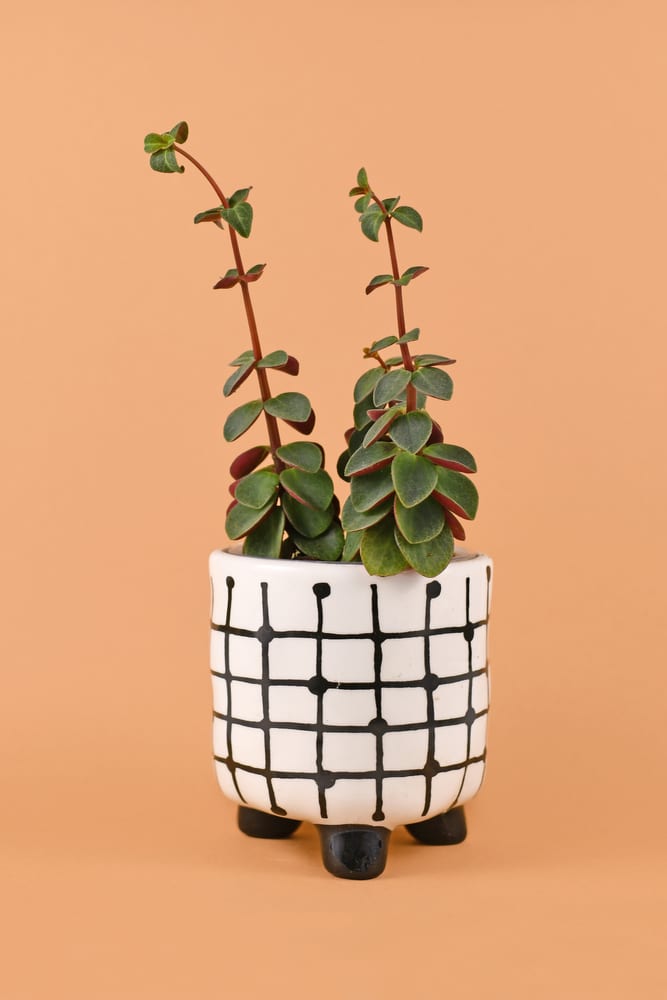
The Elongatta peperomia plant reaches 12 inches in height when mature.
©Firn/Shutterstock.com
An Elongata variety of the peperomia plants will be 12 inches when mature. These peperomia types are native to South America. These plants are rare. However, they are being tested as drugs for the treatment of certain types of cancer. They are beautiful, and small, moreover they are suprisingly easy to care for.
The elongated leaves of the plant are medium to deep green in color. Indirect sunlight is required to stop the leaves from developing leaf rot spots.
16. Emerald Ripple Peperomia
8 inches is the mature height of the Emerald Ripple peperomia plant. The plants are unique and make excellent houseplants. They are native to tropical locations so it requires warm temperatures and indirect sunlight. The leaves of these plants are deeply furrowed, moreover they have cream colored flowering structures. The leaves are a deep greenish purple color.
17. Hope Peperomia; (Acorn Peperomia, Four-leaved Peperomia Trailing Jade)

This plant is called the Hope Peperomia.
©eunhahaeun/Shutterstock.com
This peperomia variety is native to Central and South America. It will bloom green and brown flowers in the spring and summer. The Hope thrives in hardiness zones of 10 and 12. The plant needs partial sun and most soil that is well drained. It has small green leaves that are shaped like coins.
18. Pereskiifolia Peperomia
The Pereskiifolia peperomia is a native of Venezuela. It is an ideal plant for growing in a hangind container in your home or office. Its leaves are widely spaced and people call it a zig-zag peperomia because of this. The foilage is a medium green with the back of the leaves looking red. They are easy to care for and do not take up much space. The plants are not messy and do not drip water on desks or floors.
19. Pixie Lime Peperomia
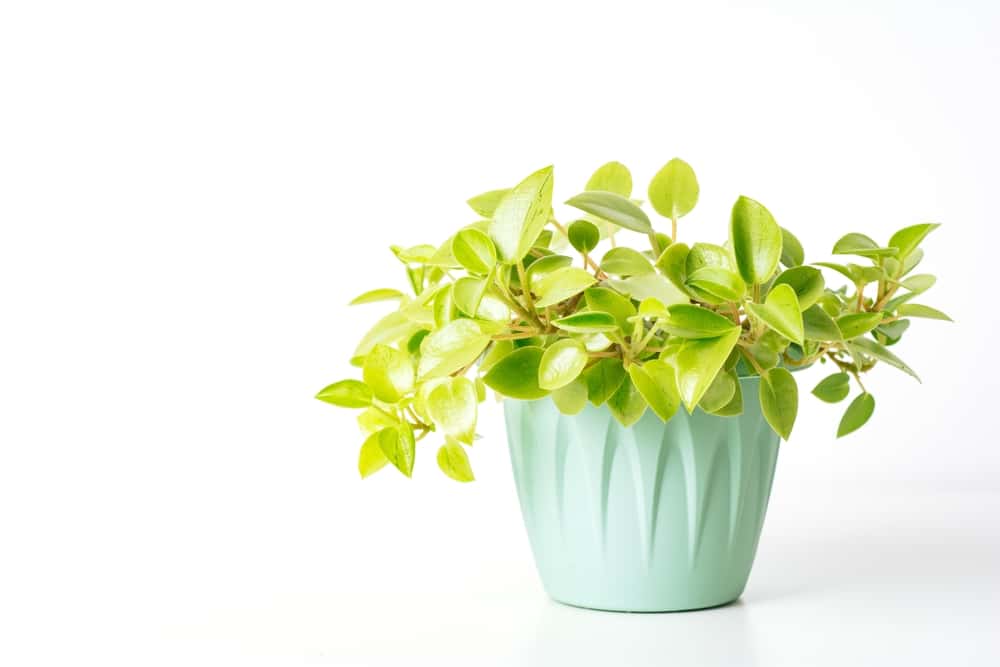
Lime green leaves are a trademark of these peperomia types.
©awindrunner/Shutterstock.com
Small lime green leaves brighten any indoor office space that has a Pixie Lime peperomia plant in it. The plant looks like spring because of the spring green leaves. It is easy to care for, however it requires soil that is neutral to acidic. It also requires full sunlight and low volumes of water in soil that drains well.
20. Prostrata Peperomia
A prostrata peperomia plant is commonly called a string of turtles. The shape of the leaves attached to the trailing vine make the plant apprear to have small turltes clinging to it. These are larger peperomia types that are endemic of Ecuador. The best container for the string of turtles is a hanging basket so the trailing vine can droop over the side.
21. Raindrop Peperomia Plant
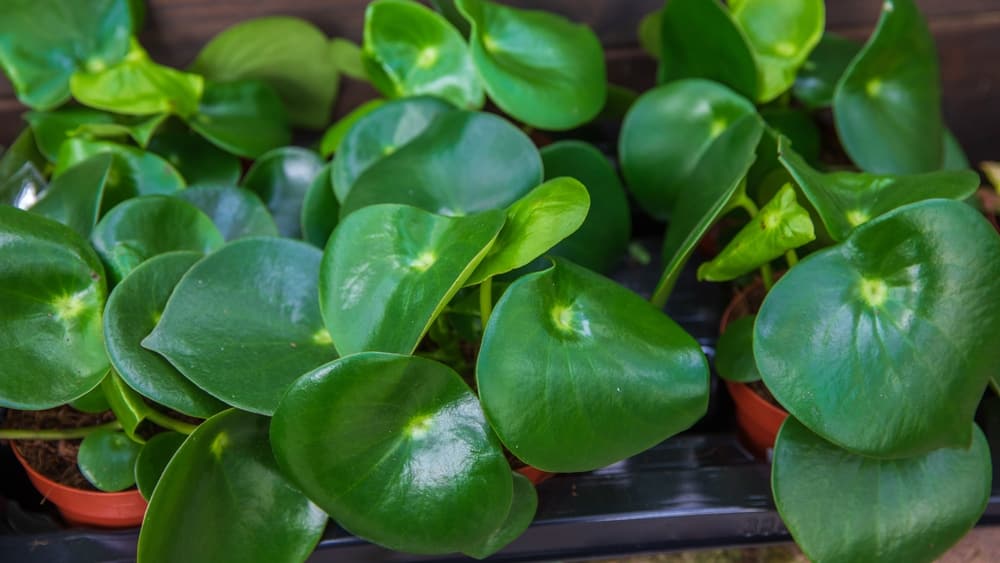
Shiny green leaves are a trademark of the Raindrop peperomia.
©S1001/Shutterstock.com
The Raindrop plant is native to Peru, Ecuador, and Colombia. Its teardrop shaped leaves with the single spot of lighter green creates a unique look for the plant. The plant brings the jungle into your home or office space. It needs indirect light, however, the light should be medium to bright. It requires little water, and soild that drains well.
22. Red-Edge Peperomia
12 inches is the mature height of the Red-Edge peperomia from Jamaica. The plant has unique variegsted leaves that are almond shaped. It is a perfect addition to an indoor space because it requires indirect light so it can sit almost anywhere. Also, the plant is small enough to be unobtrusive sitting on a desk or shelf.
23. Red Ripple Peperomia
The Red Ripple peperomia requires indirect light, however, that light should be medium to bright. It needs very little water, and can go for nine days or more without any water. As an indoor plant it can be kept in containers or in a hanging basket. It is a lovely addition to an indoor succulent garden.
24. Rosso Peperomia
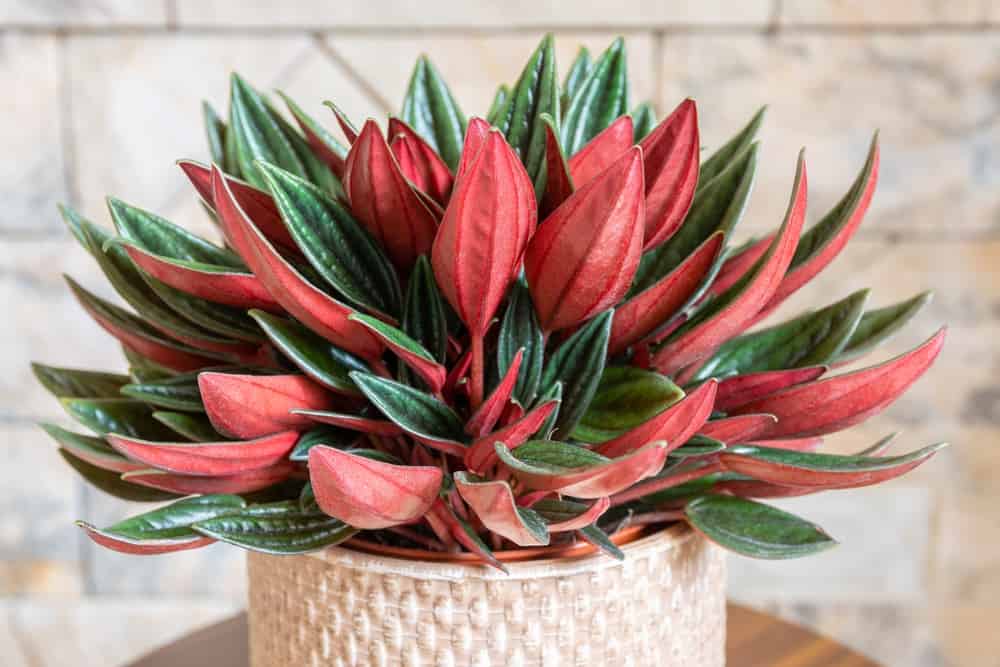
The Rosso Peperomia is native to
Africa
and Southern Asia.
©CoinUp/Shutterstock.com
This stunning and unique variety of peperomia is native to Africa and Southern Asia. The colors of the foilage make it the perfect addition to your home or office during the Christmas holiday season. The mottled red of the elongated leaves stand crips against the dark green foiliage. Keep it in indirect sunlight and in a room that has a humidity of up to 70%.
25. Rubella Peperomia
The Rubella peperomia is a miniature species of peperomia. It grows wild in Ja,aica. This is the perfect plant to grow in a shallow container, or to use as a groundcover in a container with another plant. The Rubella requires minimum attention, however the soil it is in must be moist not wet.
26 . Ruby Cascade Peperomia
These peperomia types that are native to Central and South America. The Ruby Cascade is a perfect plant for a hanging basket in your home or office garden. The controlled climates of your home protect them from direct sunlight and too much water. The light green leaves stand out against the reddish viney stems that cascade down the sides of the containers the plant lives in.
27. Ruby Glow Peperomia
A Ruby Glow Peperomia is a native plant of Peru and Ecuador. Their stems are reddish and their leaves are medium green on the top and reddiszh on the bottom. When they are mature they stand 10 inches. They make great houseplants because they need very little care and grow nicely in containers and pots.
28. Serpens Peperomia
These are the small peperomia types that are native to Central and South America. The heart shaped leaves of the Serpens Peperomia are medium green. It is an excellent plant for hanging baskets and indoor spaces. They are easy to care for however, they require very little water.
29. Silver Ripple Peperomia
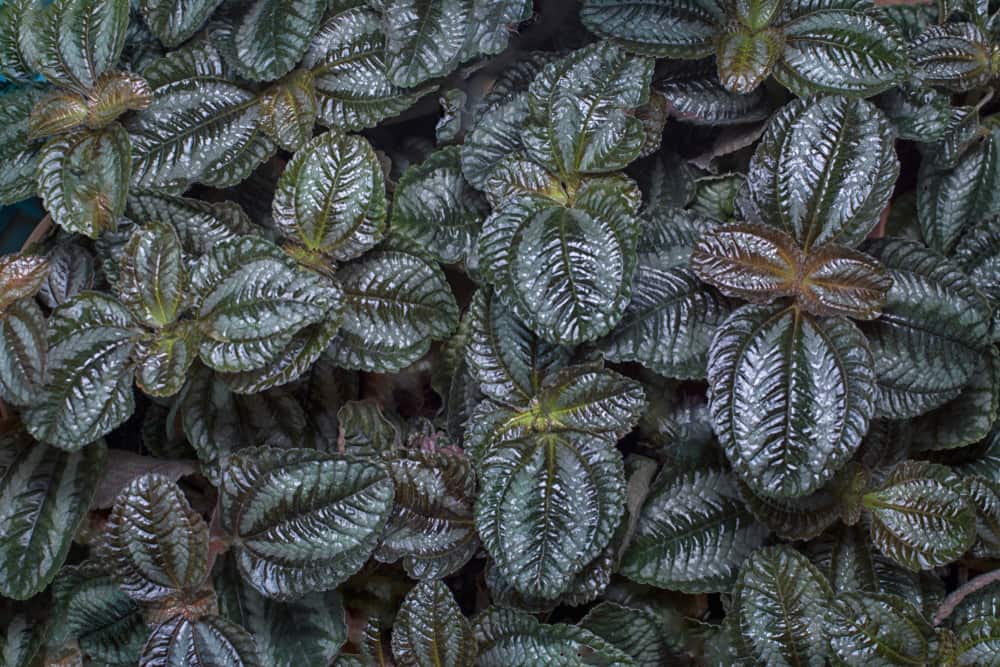
The silver ripple peperomia reaches a mature height of 8 inches.
©Young Swee Ming/Shutterstock.com
8 inches is the mature height of the Silver Ripple peperomia plant from the jungles of South America. The plant grows beneath the protective cover of the trees. It is a evergreen herbaceous groundcover with unique looking foiliage. In your garden it is an excellent addition to indoor spaces that are climate controlled. They are easy to care for, and go long periods without needing water.
30. Taco Peperomia
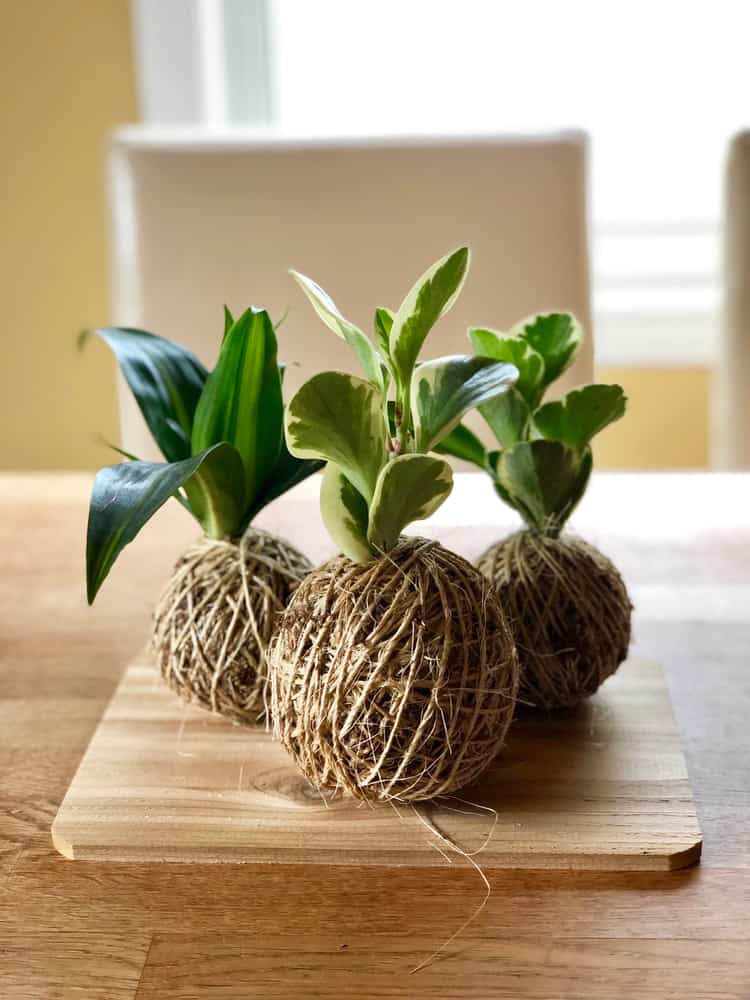
The Taco Peperomia plants are native to Southern Florida and the Carribbean.
©Caicos/Shutterstock.com
12 inches is the maximum height of the Taco peperomia. The plant is native to Southern Florida and the Carribbean. In the wild it grows under the cover of trees, therefore in your garned it requires partial shade or indirect sunlight. It is an easy to care for plant, however, it requires specialized potting soil that is aerated.
31. Teardrop Peperomia
20 inches These are larger peperomia types that are native to Central America and tolerates warmer temperatures and humidity levels as high as 80%. It is a semi-succulent plant that does not require much water. It is a perfect plant for an indoor garden, however, it requires indirect light. You can grow the plant in a small container or in a suspended basket. The leaves are shiny and deep green.
32. Tetragona Peperomia
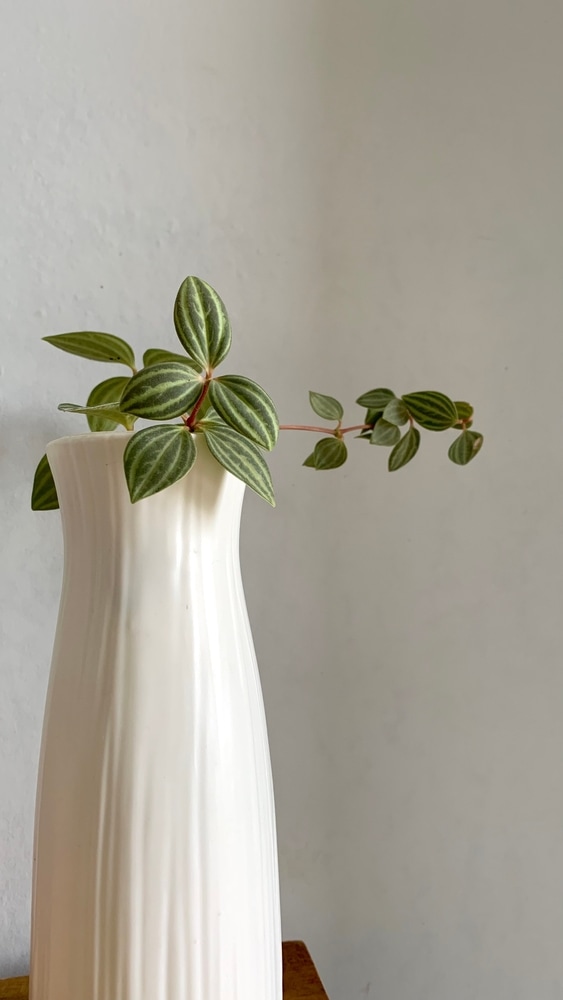
A Tetragona Peperomia is native to Paraguay, Ecuador and Peru.
©Betty Inggrita/Shutterstock.com
16 inches is the mature height of the Tetragona Peperomia. The plant is native to Paraguay, Ecuador and Peru. It has almond shaped leaves with dark and light green stripes. The plant requires warm temperatures and is not cold tolerant. However, the plant is drought tolerant and makes a great office plant because it can survive several days without water.
33. Varigated Teardrop Peperomia
The maximum height of 12 inches is the average size for these peperoni types. It has large, thick leaves, however it looks delicate. The white flowers are spiked and narrow. This plant is native to Central America. It is an excellent indoor plant for gardens that are grown for the unique ornamental foilage instead of the beauty of their flowers.
34. Wax Privet Glabella Peperomia
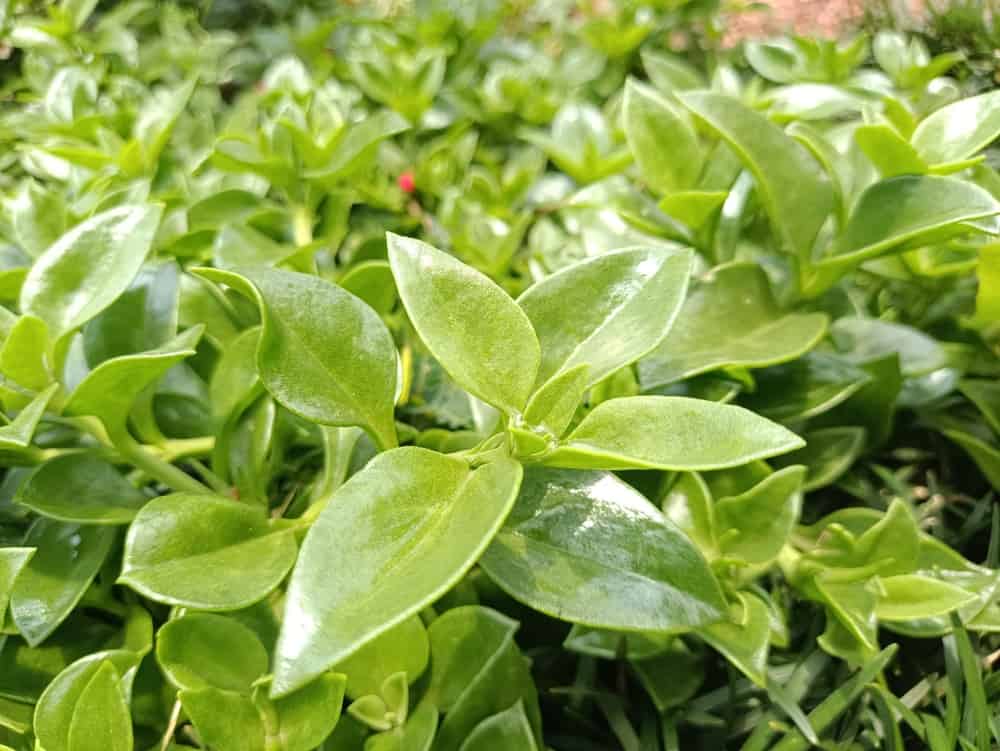
The Wax Privet Glabella is easy to care for and makes a great plant for your desk.
©Sam.Cao68/Shutterstock.com
This variety of peperomia has broad leaves that are medium shades of green. They are great as desk plants, however, they require high humidity. Planting them in a terrarium or in a hanging pot are both good options. A mature plant will reach a maximum height of 12 inches.
Peperomia Care Tips
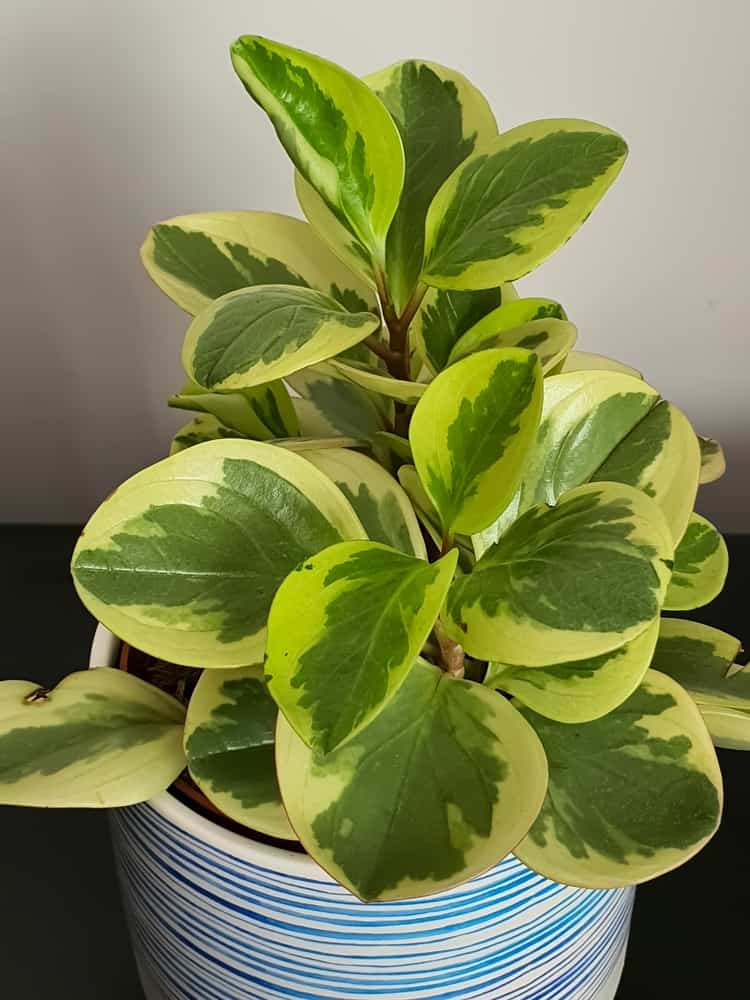
Image: Dan Gabriel Atanasie, Shutterstock
©Dan Gabriel Atanasie/Shutterstock.com
- Protect the plants from bright light.
- Place pots away from radiators.
- Place containers away from drafts.
- Keep soil moist, however, do not overwater.
- Feed monthly during the spring.
Summary of 34 Types of Peperomia and Which Is Best For Your Garden
| # | Type | Peperomia Scientific Name |
| 1 | Albovittata | albovittata |
| 2 | American Rubber Plant | obtusifolia |
| 3 | Argyreia | Sandersii |
| 4 | Aussie Gold | Rugosa |
| 5 | Beetle | quadrangularis |
| 6 | Belly Button | verticillata |
| 7 | Bibi | trinervula |
| 8 | Brazilian | pellucida |
| 9 | Citrus Twist | obtusifolia |
| 10 | Columbian | metallica var. columbiana |
| 11 | Columella | columella |
| 12 | Cubensis | cubensis |
| 13 | Cupid | scandens |
| 14 | Dahlstedtii | roccaa scuro |
| 15 | Elongata | elongata |
| 16 | Emerald Ripple | caperata |
| 17 | Hope | deppeana×quadrifolia |
| 18 | Pereskiifolia | pereskiifolia |
| 19 | Pixie Lime | obtusifolia |
| 20 | Prostrata | Prostrata |
| 21 | Raindrop | polybotrya |
| 22 | Red-Edge | clusiifolia |
| 23 | Red Ripple | caperata |
| 24 | Rosso | caperata |
| 25 | Rubella | Rubella |
| 26 | Ruby Cascade | Ruby Cascade |
| 27 | Ruby Glow | graveolens |
| 28 | Serpens | Serpens |
| 29 | Silver Ripple | Caperata |
| 30 | Taco | axillaris |
| 31 | Teardrop | orba |
| 32 | Tetragona | tetragona |
| 33 | Varigated Teardrop | orba |
| 34 | Wax Privet Glabella | glabella |
Thank you for reading! Have some feedback for us? Contact the AZ Animals editorial team.







